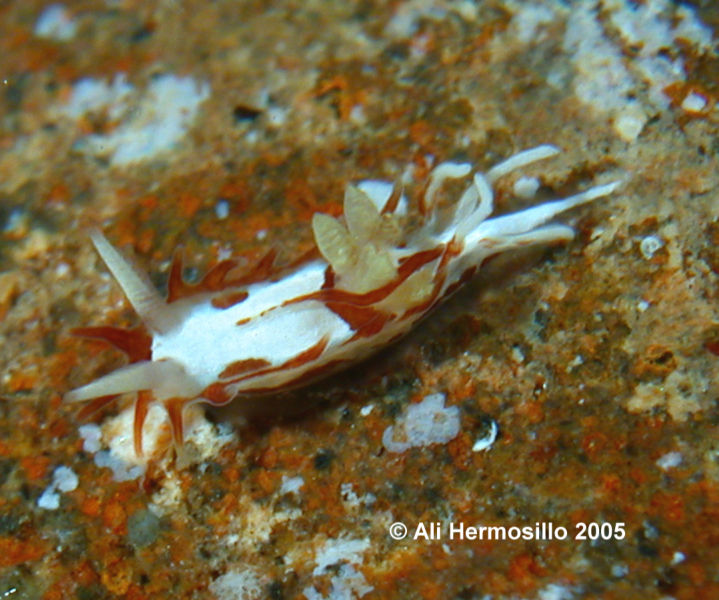 |
Okenia mexicorum
Photo courtesy of Ali HermosilloBahia de Banderas, Puerto Vallarta, Mexico
Okenia mexicorum Gosliner & Bertsch, 2004
Patronyms are quite special to me. Since naming my first new species Chromodoris baumanni in honor of my high school biology teacher, Father Anthony Baumann, O.F.M., I have had the privilege of naming (among others) Mexichromis antonii (Antonio J. Ferreira), Hypselodoris ghiselini (Michael Ghiselin, my doctoral professor at University of California, Berkeley), Tritonia myrakeenae (of course!), and Trapania goslineri (Terrence Gosliner—what else?)
Over 30 years of “slugging” together, respect, and friendship).
So this Nudibranch of the Week brings me a sense of pride and humility. Just last September, Terrence Gosliner and I named three new species of Okenia from the eastern Pacific and the Gulf of California. A few weeks ago, I presented Okenia angelica as a BOW. This week: Okenia mexicorum.
As stated in our description, “The specific name, mexicorum, honors our outstanding young Mexican colleagues, Alicia Hermosillo and Orso Angulo Campillo who have advanced greatly our understanding of the opisthobranch fauna of the tropical Americas.”
This species is only known from two locations: Bahía de Banderas, Jalisco, and Ensenada de los Muertos, Baja California Sur, México.
Living animals are 5-8 mm in length. “The body color is translucent white with an extensive opaque white patch on the center part of the notum that extends from the level of the rhinophores to the posterior end of the foot. External to this white patch are brick red pigmented areas that extend along the notal margin and are also present on the eight to ten pairs of lateral papillae and on the single, elongate medial papilla located immediately anterior to the gill. This papilla is found at the posterior end of a long, elevated medial ridge. Red pigment patches are also found on the lateral sides of the body. Two pairs of these papillae are found anterior to the rhinophores while the remaining ones are posterior and extend to the level posterior to the gill. The posterior two papillae per side are much longer than the more anterior ones and do not share a common base. The rhinophores are uniformly white and have 7-9 simple lamellae. The apices of a few of the more posterior lateral papillae have p opaque white or translucent white pigment. The gill consists of five to six unipinnate branches which bear mottled brick red pigment on their surfaces. The anterior end of the broad foot is simply rounded without distinct oral tentacles. The genital aperture is situated on the right side of the body approximately a third of the length of the body posterior to the head” (Gosliner & Bertsch, 2004, pp. 427-428).
No other species of Okenia has a whitish body color with red markings.
Shortly after Terrence Gosliner’s and my article was printed, Dr. William B. Rudman published a complementary research paper . on Okenia from the other half of the Pacific Ocean titled:
“Further Species of the Opisthobranch Genus Okenia (Nudibranchia: Goniodorididae) from the Indo-West Pacific.” In this paper, he names five new species, each with distinctive etymologies.
References
Gosliner, Terrence M., & Hans W. Bertsch. 2004. Systematics of Okenia from the Pacific Coast of North America (Nudibranchia: Goniodorididae) with Descriptions of Three New Species. Proceedings of the California Academy of Sciences 55 (22): 414-430.
Rudman, W. B. 2004. Further species of the opisthobranch genus Okenia (Nudibranchia: Goniodorididae) from the Indo-West Pacific. Zootaxa 695: 1-70.
Imperial Beach, Calif
May 2005